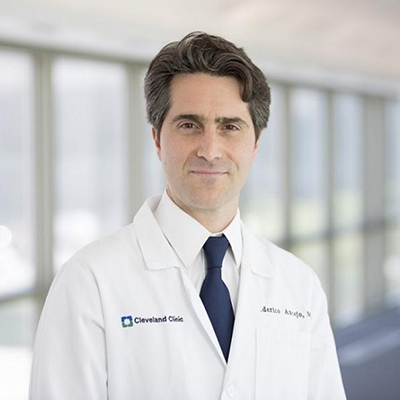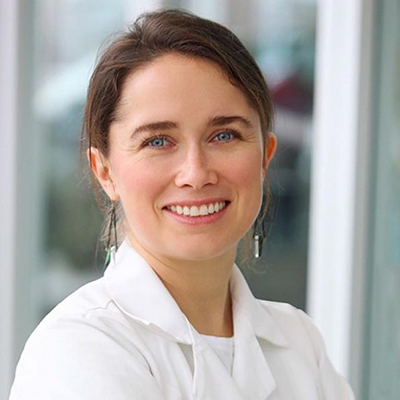Why I Ride
Inspiration is Everywhere
Why do you ride VeloSano?
Learn more about VeloSano, a year-round, community driven fundraising initiative with the mission to advance lifesaving cancer research at Cleveland Clinic. The flagship event is “Bike to cure” weekend taking place each July. 1OO% of the dollars raised through VeloSano directly supports the cause and in just four years, over $12.5 million is already hard at work in the fight against cancer.
Waiting to Exhale: A New Diagnostic Tool for Liver Cancer?

Federico Aucejo, MD, liver surgeon and Director of Cleveland Clinic’s Liver Cancer Program, believes that exhaled breath may hold a key to diagnosing liver cancer in persons with chronic liver disease. That’s just one of the ways in which Cleveland Clinic liver tumor researchers are working to find new ways of diagnosing and treating liver cancer.
Liver cancer is a leading cause of cancer deaths worldwide, accounting for more than 600,000 deaths each year. In 2018, more than 42,000 cases of liver cancer will be diagnosed in the U.S., and it is estimated that more than 30,000 deaths will occur because of it. Nonalcoholic fatty liver disease is a leading cause of liver cancer, along with obesity and cirrhosis. Because of new effective therapies, it’s expected that hepatitis C virus infection-induced cirrhosis will decline.
Treatment for liver cancer includes surgery, radiation and chemotherapy. Unfortunately, only one-third of liver cancer patients are eligible for surgical treatments because most diagnosis are made at advanced stages.
Collected Breath Analysis Data Shows Trends
“There are different components in everyone’s breath – different metabolites that can be measured,” Dr. Aucejo says. “We’ve observed there are variations in these components based on different conditions, so healthy people have different profiles from people with disease.”
Two years ago, he and his team began collecting breath samples from all patients of the Liver Tumor Clinic, including those with primary liver cancer, cholangiocarcinoma or bile duct cancer, and liver metastasis from colorectal cancer. Samples also were taken from patients before and after treatment to see if there were variations.
Now, with over 400 breath samples to compare, Dr. Aucejo says trends are emerging.
“We’ve seen that patients with cancer had some components of the breath suppressed. They had lower levels of these components compared to patients without liver tumors.”
But, he cautions, in order to draw concrete conclusions, a much larger data set is needed.
Liver Tumor Center of Excellence
A team of basic and clinical researchers has established a rapidly growing biorepository, which houses samples from breath, blood, saliva and tissue. Clinical data, such as patient demographics, imaging, and information on liver tumors, also is gathered. The liver cancer biorepository was developed as part of the Cleveland Clinic Liver Tumor Center of Excellence, a comprehensive multidisciplinary operational platform established in 2017. The center brings together clinicians from multiple specialties including surgery, oncology, hepatology and interventional radiology, and scientists forming a unit focused on advanced, coordinated, liver cancer patient-centered care.
Many more breath samples are needed for the biorepository before Dr. Aucejo can, with the help of artificial intelligence, discover common patterns. “Once we have a large sample size, along with tumor biologic information obtained from other biospecimens, we can then build algorithms to risk stratify patients and react accordingly in more effective ways”.
Breath analysis could be a new, inexpensive and highly accessible diagnostic tool performed at a pharmacy or during a patient’s annual physical. The goal, Dr. Aucejo says, is to detect early so we can treat early and therefore save lives.
“We’ve been fighting cancer for decades.”
Currently, the studies into breath analysis are funded through grants, including VeloSano and the Mikati Foundation. Dr. Aucejo hopes that soon the Liver Cancer Center of Excellence research will meet the criteria for a National Institutes of Health grant application. Additional philanthropic funding could hasten this process, he says. “This is a unique effort oriented to a prevalent and still non-curable disease. We’re putting together all of the pieces to develop diagnostics and therapeutics precision medicine platforms.”
Dr. Aucejo is tenacious in his attitude toward cancer. “Cancer pathophysiology is fascinating, how it can develop, then trick the immune system and defense mechanisms,” he says. “We’ve been fighting cancer for decades and still … it’s a very smart disease and there are many different ways to approach it.”
How You Can Help
Your support of innovative research like Dr. Aucejo’s helps find cures that save lives.
Seeing Cancer from Both Sides

Caroline Farrington, 36, has spent years as a researcher seeking better cancer treatments, her passion fueled by seeing friends and mentors struggle with the disease. In July 2017, she took her commitment even further, riding 200 miles in VeloSano, an annual biking event that supports cancer research at Cleveland Clinic.
In November, she was diagnosed with Stage 3B colon cancer.
“What this means is that the doctors found a large tumor in my colon,” she wrote in her VeloSano blog post. “And upon its removal, the doctors confirmed the presence of cancer in neighboring lymph nodes.”
Early Signs
For a few years before the diagnosis, Caroline experienced symptoms that she thought were annoying but harmless, and a physician at the student health center of Case Western Reserve University concurred. However, she was advised to see a gastrointestinal specialist if her symptoms worsened or if she could not identify any foods that triggered them.
“This went on for a few years,” she says. “I actually made two previous appointments with specialists over the course of two or three years but canceled them because I was feeling good as the appointments approached. I finally kept my third one because the symptoms got worse and caused me to worry more. The doctor scheduled my colonoscopy as a precautionary measure, not expecting to find a tumor. But that procedure is what led to its discovery.”
In December, Caroline began a course of 12 chemotherapy treatments that she finished in May.
“This experience has been intense and scary, and really freaking hard,” she wrote in her blog. “But it has taught me a great deal about our capacity as humans to take on life’s challenges and thrive or learn something new.”
Caroline now is training for her second 200-mile VeloSano ride in July. This time, her commitment is even deeper and more personal than it was before, she says.
Lessons Learned
She says that what she knew as a researcher helped her understand the disease and treatment intellectually, but her experience as a patient revealed gaps between that knowledge and the raw emotional and physical aspects of treatment. What she learned firsthand will inform her research going forward, she says.
“I understood the chemotherapy; how it worked, its history,” she says. “But I didn’t know the process of being a patient and the treatment’s side effects and fears accompanying it. In the past, I’ve given many presentations about cancer, outcomes, numbers and patients -- but it’s very different when it’s you.”
Writing a blog has helped her, she says. “Every patient processes their experience differently. My technical understanding made it easy for me to talk about it, and I liked to talk about it. I found my voice and shared it with people through my blog, and I informed them and let them know about the treatment process in real time. I had to get it out.
A Change in Plans
Caroline’s experiences are shaping a possible career path, she says. “It's given me a lot to think about as I finish my PhD in pharmacology in the cancer therapeutics training program. A part of me now wants to look beyond bench research to the clinical side and find a way that connects the two. I think I found my voice in educating people about the treatment process. I don’t know whether I’ll pursue patient education or other roles, but this whole experience has made me hone these skills.”
She recently returned to her job at the Case Comprehensive Cancer Center, a consortium that includes Cleveland Clinic, where she is researching novel treatment approaches that one day may lead to new drugs for patients with lymphoma, breast and lung cancer. In her spare time, she prepares for VeloSano, riding with the Case Comprehensive Cancer Center team.
“I like riding with the team to draw attention to the consortium and collaboration across the major institutions in Cleveland,” she says. “Many people don’t realize that Case Western and Cleveland Clinic faculty collaborate together on lots of exciting projects, and that is part of what makes our research community so strong. Collaboration is key to driving research forward. Nothing occurs in a box by one person. We all contribute different strengths, from basic science to clinical research.”
Riding with VeloSano is a way of connecting with others while getting the message out, she says.
“For patients, VeloSano is a unique way to find camaraderie while going through this experience, whether they do it with friends or family or other patients,” she says. “It’s a nice way for friends and family to support them and to get the community to understand that research is a big part of their care.”
How You Can Help
Visit VeloSano.org to discover how you can support cancer research at Cleveland Clinic.
More Research Funding, or More Nursing Homes?
Neurodegenerative Diseases at a Crossroads: More Research Funding, or More Nursing Homes?
Cleveland Clinic researchers make the case for investigative urgency
Will we fight neurodegenerative diseases the way we took on HIV/AIDS — or with the limited attention we have devoted to combating malaria?

